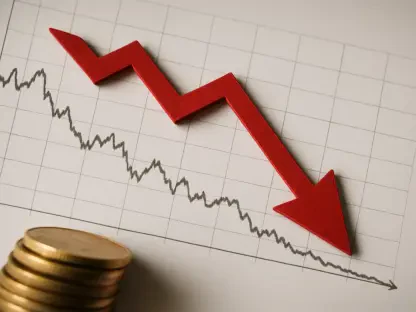What happens when a single economic report sends shockwaves through the financial world, only for markets to hint at a comeback mere days later? Last Friday, Wall Street took a nosedive after a disappointing U.S. jobs report revealed just 73,000 new positions added in July, far below expectations. Yet, as Monday morning approaches, futures for major indices like the S&P 500 and Nasdaq are flashing green with gains of 0.5% to 0.7%. This rapid shift from panic to optimism raises critical questions about the stability of the economy and the forces driving investor behavior. Dive into this rollercoaster of market sentiment to uncover what’s fueling the anticipated recovery and what challenges still loom on the horizon.
A Volatile Weekend for Markets—What Lies Ahead?
The past few days have been a whirlwind for Wall Street, with last Friday’s sell-off painting a grim picture of investor confidence. The dramatic reaction stemmed from a labor report that not only showed weak job growth but also revised down prior months’ figures by a staggering 258,000 jobs. This data painted a troubling image of a slowing economy, catching many traders off guard and triggering a rush to sell.
Now, just over the weekend, a different story seems to be emerging. Futures for key U.S. indices are pointing toward a positive opening on Monday, suggesting that some investors see the dip as a buying opportunity. This quick pivot highlights the fragile balance between fear and hope in today’s financial landscape, where every piece of data can tip the scales.
The stakes are high as the opening bell nears, with market participants keenly aware that this rebound could set the tone for the week. Beyond the numbers, this moment reflects broader anxieties about economic health and the ability of policymakers to steer through uncertain waters. Understanding these swings is essential for anyone tracking the pulse of Wall Street.
Why the Jobs Report Rattled Investors—and Its Wider Impact
At the heart of last week’s market turmoil lies the U.S. Labor Department’s latest report, a stark reminder of economic fragility. With only 73,000 jobs added in July—well below forecasts—and significant downward revisions to earlier data, the figures suggest a labor market struggling to maintain momentum. This isn’t just a statistic; it’s a signal of potential hardship for millions who rely on steady employment and wage growth.
The ripple effects extend far beyond trading floors. A weakening job market can erode consumer confidence, slow spending, and put pressure on businesses already grappling with rising costs. For everyday Americans, this translates into uncertainty about financial stability, making the report a critical piece of the economic puzzle that affects more than just stock prices.
Moreover, the data has intensified scrutiny on the Federal Reserve’s next steps. Policymakers now face a dilemmhow to support growth without losing control of inflation, which still hovers above the 2% target. The implications of this balancing act will likely shape market expectations and household budgets alike in the coming months.
Unpacking the Expected Recovery—What’s Driving It and What’s at Risk?
As Monday’s trading session approaches, several factors are converging to fuel Wall Street’s anticipated bounce-back. Futures for the S&P 500, Dow Jones Industrial Average, and Nasdaq are signaling gains between 0.5% and 0.7%, reflecting a wave of bargain hunting after Friday’s steep losses. This renewed optimism suggests that some investors view the sell-off as an overreaction, creating openings for strategic buys.
Yet, other elements are also at play in this recovery narrative. Growing expectations of a Federal Reserve interest rate cut in September—the first in nearly a year—could provide a much-needed boost to the economy by lowering borrowing costs. However, this move carries risks, as easing monetary policy might reignite inflationary pressures, a concern for both central bankers and market analysts monitoring the 2% target.
Adding to the complexity are upcoming corporate earnings from heavyweights like The Walt Disney Co., McDonald’s, and Caterpillar, set to release reports this week. These results will offer fresh insights into consumer trends and industrial strength, potentially reinforcing or undermining the rebound. Meanwhile, external threats such as Boeing’s ongoing labor strike, involving over 3,200 workers, and policy uncertainties like sweeping tariff proposals from former President Trump, which could raise costs for companies like Walmart, continue to cast shadows over the outlook.
Global Perspectives and Expert Takes on the Market Shift
Across the globe, financial markets are presenting a mixed picture that contextualizes Wall Street’s expected upturn. In Europe, indices are showing strength, with Germany’s DAX climbing 1.2% and France’s CAC 40 rising 0.8% at midday, signaling a wave of positivity. Conversely, Asia’s performance varies, as Tokyo’s Nikkei 225 slipped 1.3% while Hong Kong’s Hang Seng advanced 0.9%, illustrating the uneven nature of global economic sentiment.
Expert voices add depth to this evolving story, with Stephen Innes of SPI Asset Management framing the recent jobs data as a shift from a “soft landing” to a “late-cycle casualty.” This perspective captures the growing unease among analysts about whether the economy can avoid a deeper downturn. Such commentary underscores the gravity of the labor report’s impact on long-term market narratives.
Energy markets, too, offer a glimpse into broader demand concerns, with U.S. crude oil dropping $1.20 to $66.13 per barrel and Brent crude falling $1.12 to $68.55. These declines hint at weakening global appetite for resources, a factor that could temper enthusiasm for Wall Street’s recovery. Together, these international and expert insights reveal the interconnected web of influences shaping U.S. markets today.
Charting a Path Through Market Turbulence—Tips for Investors
Navigating the current financial climate requires a blend of vigilance and adaptability for investors aiming to capitalize on opportunities while managing risks. One key focus should be the Federal Reserve’s signals on interest rates, as a potential September cut could favor sectors like technology that thrive in lower-rate environments. Adjusting portfolios to reflect this possibility might offer a strategic edge.
Attention must also turn to this week’s corporate earnings, which could serve as a litmus test for economic resilience. Strong performances from consumer-driven companies like Disney might bolster confidence in market stability, providing actionable data for investment decisions. Staying attuned to these reports can help in making informed choices amid fluctuating conditions.
Finally, mitigating risks tied to policy and labor disruptions is crucial. Diversifying holdings to include industries less vulnerable to trade tariffs, such as domestic-focused firms, can shield against sudden cost hikes. Similarly, tracking developments in disputes like Boeing’s strike will be vital, as prolonged conflicts could drag on related sectors. These steps provide a framework for weathering volatility while positioning for potential growth.
Looking back, the whirlwind of events surrounding Wall Street’s reaction to the jobs data underscored the fragility of economic confidence. The sharp sell-off on Friday, followed by signs of recovery on Monday, revealed how swiftly sentiment can shift in response to new information. Beyond the numbers, the broader implications for American workers and businesses came into sharp focus, highlighting the stakes of each policy decision.
Reflecting on those tense days, the path forward demands a proactive stance from all market participants. Investors are encouraged to stay informed on Federal Reserve actions, as future rate adjustments could redefine economic priorities. Businesses, meanwhile, must prepare for potential tariff impacts by exploring cost-effective supply chains. For policymakers, the challenge remains to balance stimulus with stability, ensuring that short-term gains do not sow seeds of long-term inflation. These actionable considerations pave the way for navigating an uncertain financial landscape with greater clarity and purpose.









